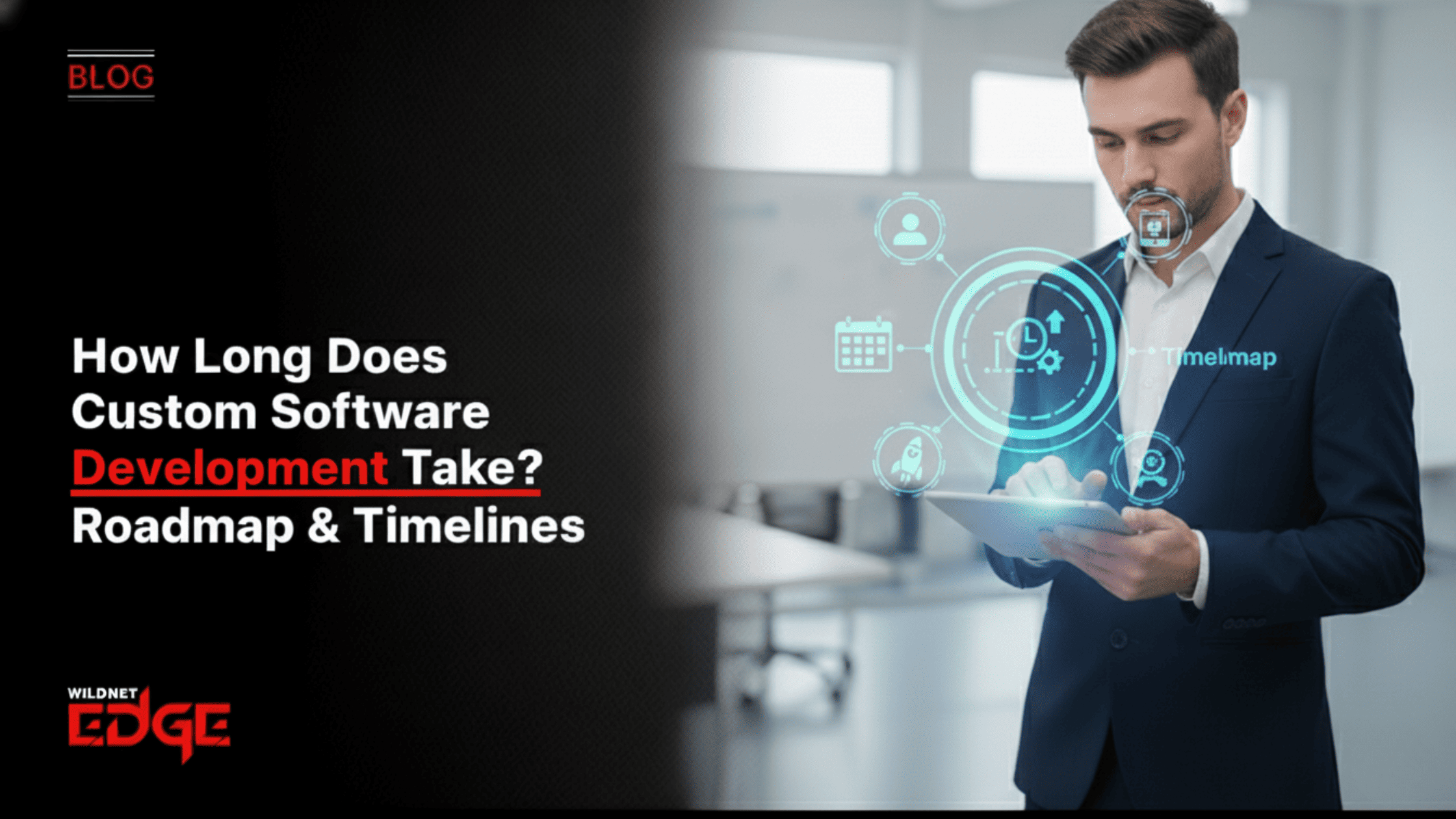TL;DR
This article provides a strategic overview of typical custom software development timelines, explaining that duration varies significantly based on project complexity. It outlines the standard enterprise project lifecycle. Key factors influencing timelines are discussed: scope complexity, team size/expertise, integration needs, and technology choices. The guide emphasises that while precise estimates require a detailed discovery phase, understanding these phases and variables allows businesses to create a realistic agile enterprise roadmap and set appropriate expectations for achieving key software delivery milestones.
“How long will it take?” It’s often the first question asked when considering a custom software project. Time is a critical resource, directly impacting budget and time to market. However, estimating a custom software development timeline isn’t straightforward, unlike buying an off-the-shelf product. There’s no single answer because every custom project is unique. This guide will break down the typical phases, influencing factors, and realistic timelines you can expect.
Why There’s No Magic Number
Building custom software is like building a custom house. Asking “How long does it take?” without providing blueprints is impossible to answer accurately. The duration depends entirely on the size, complexity, features and finishes required. Similarly, software timelines are influenced by:
- Scope Complexity: How many features? How intricate are they?
- Team Size & Expertise: How many developers? How experienced are they?
- Integrations: Does it need to connect with many existing systems?
- Technology Stack: Are you using standard or niche technologies?
- Methodology: Agile approaches often deliver value faster, iteratively.
A reliable estimate only comes after a thorough discovery and planning phase where these details are defined.
The Typical Enterprise Project Lifecycle Phases & Timelines
While every project varies, the development process generally follows these key phases, each contributing to the overall custom software development timeline. Understanding these software delivery milestones helps in planning.
Phase 1: Discovery & Planning (1-4 Weeks)
This is arguably the most crucial phase. It involves deep collaboration between your team and the development partner to:
- Define clear business goals and objectives.
- Map user flows and define detailed feature requirements.
- Analyze technical feasibility and potential risks.
- Create a prioritized feature list (often for an MVP).
- Develop an initial project roadmap and high-level estimate. Investing time here prevents costly misunderstandings later. Effective planning often utilizes custom project planning frameworks.
Phase 2: UI/UX Design (2-6 Weeks)
Once requirements are clear, the design phase begins. This involves:
- Creating wireframes and interactive prototypes.
- Designing the visual interface (UI) and user experience (UX).
- Finalizing the look, feel, and flow of the application. The duration depends on the complexity of the interface and the number of screens.
Phase 3: Development (3-9+ Months)
This is typically the longest phase where the actual coding happens. Using an Agile methodology, this phase is broken down into “sprints”.
- Sprint Planning: Defining tasks for the upcoming sprint.
- Development: Writing and unit testing the code for specific features.
- Sprint Review: Demonstrating completed work to stakeholders.
- Retrospective: Improving the process for the next sprint. The total duration depends heavily on the MVP scope and overall project complexity. A focus on enterprise app development sprints ensures steady progress.
Phase 4: Testing & Quality Assurance (throughout Development)
Testing is not a separate phase at the end but an ongoing activity integrated within each sprint.
- Unit Tests: Developers test individual code components.
- Integration Tests: Testing how different modules work together.
- End-to-End Tests: Testing complete user flows.
- User Acceptance Testing (UAT): Stakeholders validate that the features meet business requirements. Rigorous testing ensures a high-quality, stable application.
Phase 5: Deployment & Launch (1-2 Weeks)
Once development and testing are complete for a specific release (like the MVP), the application is deployed to the production environment. This involves:
- Preparing servers and infrastructure.
- Migrating data (if necessary).
- Final deployment checks.
- The official launch. Efficient deployment often relies on continuous deployment & cloud delivery practices.
Phase 6: Ongoing Maintenance & Iteration (Post-Launch)
The launch isn’t the end. Custom software requires ongoing maintenance bug fixes, security patches, OS updates and future iterations adding new features based on user feedback. This phase is continuous throughout the software’s lifecycle.
Key Factors Influencing Your Timeline
Understanding these variables helps set realistic expectations.
- Scope Complexity: The biggest driver. More features, complex logic, and unique requirements significantly increase time.
- Integration Needs: Connecting with numerous third-party APIs or legacy systems adds considerable complexity and time.
- Team Size and Expertise: A larger, more experienced team can often move faster, but also increases cost. Lack of specific expertise can cause delays.
- Technology Stack Choice: Using very new or niche technologies might have a steeper learning curve or smaller talent pool, potentially slowing things down.
- Stakeholder Availability & Feedback Speed: Delays in providing feedback or making decisions during sprints can significantly impact the overall custom software development timeline.
Case Studies
Case Study 1: A Startup’s Rapid MVP Launch
- The Challenge: A SaaS startup needed to launch their MVP within 4 months to meet investor milestones. Scope control and speed were paramount.
- Our Solution: We conducted an intensive 2-week discovery phase to ruthlessly prioritize MVP features. We used an agile approach with 2-week sprints and leveraged a cross-platform framework (Flutter) to accelerate development. This involved our rapid product engineering services.
- The Result: The MVP was successfully designed, developed, tested, and deployed in just under 4 months. The clear initial scope and agile process were key to hitting the aggressive deadline.
Case Study 2: An Enterprise System Modernization
- The Challenge: A large enterprise needed to replace a critical, complex legacy system. The project involved migrating decades of data and integrating with numerous other internal systems. A phased rollout was necessary.
- Our Solution: We created a detailed, multi-phase agile enterprise roadmap. The project spanned 18 months, delivered in three major releases. We used automated testing extensively and maintained close communication with internal stakeholders throughout each sprint.
- The Result: The complex modernization was completed successfully, on time, and within the planned budget phases. The phased approach minimized disruption, and the iterative feedback ensured the final product met the evolving needs of the enterprise.
Our Technology Stack & Methodologies
We leverage modern tools and processes for efficient delivery.
- Methodologies: Agile (Scrum, Kanban)
- Project Management: Jira, Azure DevOps
- Backend: .NET, Java, Python, Node.js
- Frontend: Angular, React, Vue.js
- Cloud Platforms: Microsoft Azure, AWS, Google Cloud
- DevOps: CI/CD Pipelines, Docker, Kubernetes, Terraform
Conclusion
Estimating a custom software development timeline requires careful planning and a clear understanding of the project’s scope. While timelines can range from a few months for a simple MVP to over a year for complex enterprise systems, a structured approach through defined software delivery milestones and agile methodologies provides the best path to predictable and efficient delivery. Investing in a thorough discovery phase is the most reliable way to get an accurate estimate and build a realistic agile enterprise roadmap.
Ready to Plan Your Next Project? At Wildnet Edge, our AI-first approach enhances our planning and execution. We build intelligent systems efficiently, providing transparency and predictability throughout the development lifecycle. Partner with us for expert guidance.
FAQs
Agile often leads to a faster delivery of the initial viable product because it prioritizes core features. While the total project might evolve over a longer period through iterations, Agile delivers usable software much sooner than traditional waterfall methods.
Scope creep adding new features or changing requirements mid-project without adjusting the timeline or resources is the most common culprit. A clear initial scope and a disciplined change management process are essential.
It can have a significant impact. Using a familiar stack with a large talent pool and rich libraries often leads to faster development than using a brand new or niche technology that requires more learning or custom work.
Active and timely stakeholder involvement speeds up the project. Quick feedback during sprint reviews and prompt decisions on requirements prevent delays. However, unavailable or indecisive stakeholders can become major bottlenecks.
Experienced development teams usually incorporate some buffer into their estimates based on complexity and risk. A general rule of thumb for clients might be to add a 10-20% contingency to the timeline provided, especially for complex enterprise project lifecycle initiatives.
The best strategy is to drastically reduce the scope of your MVP to the absolute bare minimum core feature set. Additionally, using rapid development frameworks (like Ruby on Rails or certain cross-platform mobile tools) and partnering with an experienced, efficient agency can accelerate the initial launch.
Without a detailed understanding of your specific requirements, features, integrations, and data migration needs, any timeline given would be a guess. The discovery phase provides the necessary clarity to create a reliable estimate and plan, preventing inaccurate software project budgeting.

Nitin Agarwal is a veteran in custom software development. He is fascinated by how software can turn ideas into real-world solutions. With extensive experience designing scalable and efficient systems, he focuses on creating software that delivers tangible results. Nitin enjoys exploring emerging technologies, taking on challenging projects, and mentoring teams to bring ideas to life. He believes that good software is not just about code; it’s about understanding problems and creating value for users. For him, great software combines thoughtful design, clever engineering, and a clear understanding of the problems it’s meant to solve.
 sales@wildnetedge.com
sales@wildnetedge.com +1 (212) 901 8616
+1 (212) 901 8616 +1 (437) 225-7733
+1 (437) 225-7733































